Review: IK Multimedia UNO Drum
IK Multimedia made a big splash in the synth world with UNO Synth. Hot on its heels comes Uno Drum, but will it be as big a hit in the world of beat-making?

Price £255 (street)/$249
Contact IK Multimedia
At the risk of sounding like a grandparent staring wistfully at an urban development and bemoaning, ‘I remember when all of this was fields’, I remember when IK Multimedia just did software. Ah, those heady days, when companies were trying to get a computer to do every music-making task and we threw all of our hardware out to pasture. Nowadays, of course, there’s been an almost total reversal in hardware’s fortunes, helped in no small part by former software-only companies such as IK Multimedia, Arturia, Native Instruments and many more deciding to get back into the hardware-manufacturing game.
These companies have responded to – and indeed helped to create – the insatiable demand for inexpensive, great-quality hardware instruments that really do help us producers look like we’re actually making music, rather than writing emails – and that has to be a good thing.
IK made huge waves last year with its first hardware synth, called UNO Synth, that delivers a big sound from a small, lightweight body. The all-new UNO Drum on test here is very much its sister product in terms of both its design and scope and could quite easily make as big an impact in the world of beat-making as Synth did in, well, synthesising.
The UNO duo
UNO Drum very much takes on the look of its sister synth, albeit in a whiter shade. It’s the same size, weighs the same, even has the same four/three rotary combination on the front panel, with the first four dials controlling a matrix of options at the top left of the device. There are differences between the two siblings, of course, so the keyboard on UNO Synth now becomes 12 drum touch-sensitive pads, beneath which sits 16 steps for sequencing.
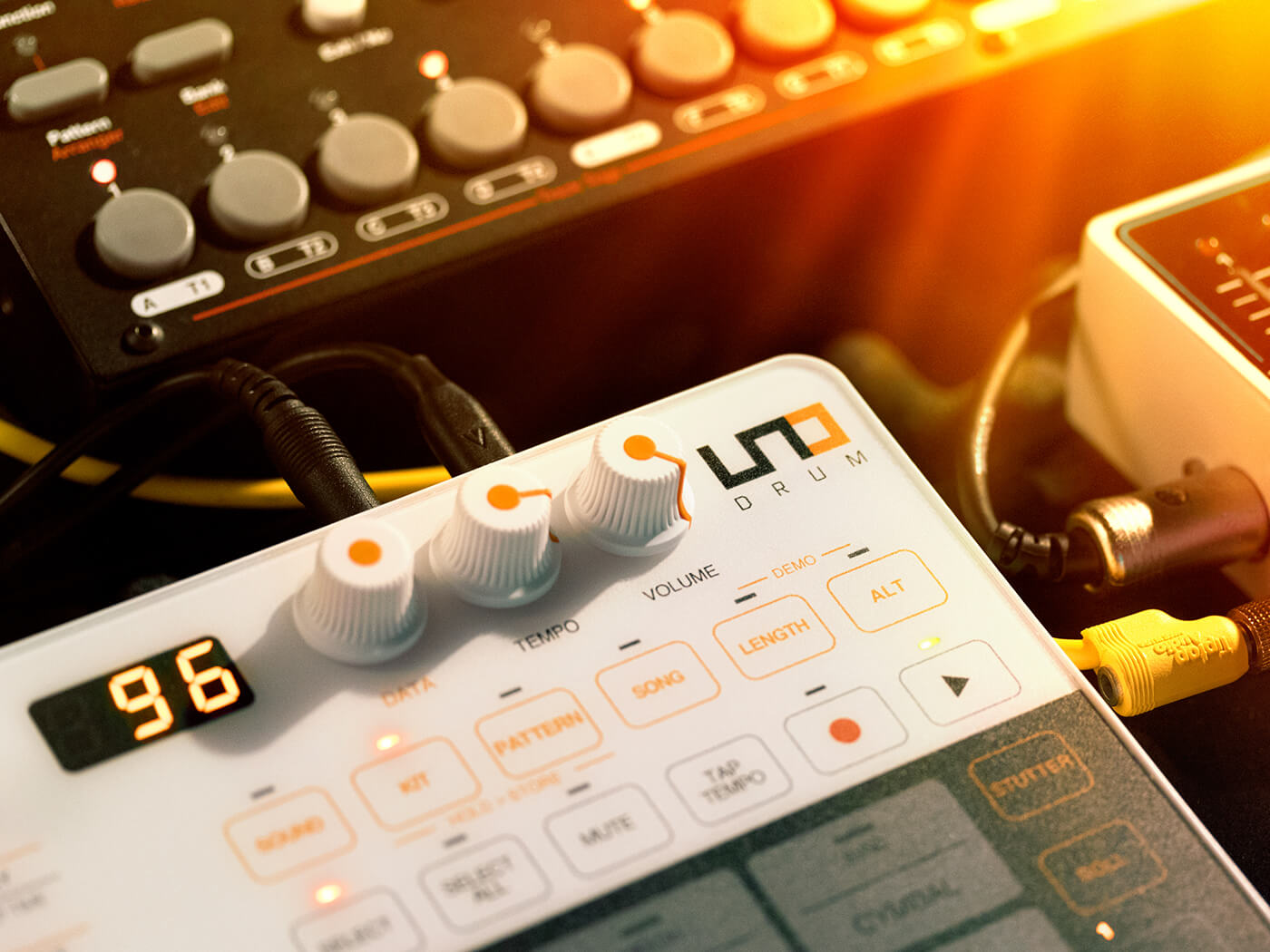
Uno Synth kept its cost down by keeping all of these moving parts to a minimum and UNO Drum does the same… to a point, because at a shade over £250 it can street at over £50 more than the synth. It has an analogue core with up to six sounds – kicks, snares, clap and hats, created by an analogue engine – and the rest of the dozen pads using digital PCM samples, from a library of 54 sounds. Finally on the comparison charts, UNO Drum can also be powered by four AA batteries or by USB and it shares the same connections (MIDI and audio I/O, plus micro USB) as the synth. That’s the end of the comparisons. Yes, they are sister products… but it’s time to beat the drum.
Drum the one
Initially, I thought UNO Drum was a good deal heavier than Synth, but removing it from the box, which contained batteries, leads and other gubbins, you soon realise that, yes, it is identical – so light in weight it might have you thinking it’s toy-like. From experience though, with many new devices in this low-cost plastic instrument league – and I’m talking about the likes of Korg’s Volcas, and Modal’s Skulpt – you should never judge hardware instrument on its weight.
Diving straight in (as you will, because the best way to experience Drum is to switch on and just play), you will probably notice some noise from the unit. IK acknowledges that ‘when connecting the UNO Drum directly to your computer via USB, you may hear more noise’, and that is the case. However, I tried switching to battery power and that didn’t really diminish it, so it could be the nature of the analogue engine, or something an update may solve (as I believe it did with Synth).
Next up, of course, you will audition each of the 12 drum sounds, or Elements, via the 12 pads. These are non-moving part pads, touchpads with a set two-layer velocity, so you don’t get that pleasing thwack of a hit you would with rubber pads on an MPC-style piece of hardware. The analogue sound will hit you right between the ears straight away though, the first kick having a huge, rich and rounded tone, at least from the kit I have loaded on power up. Each of these 12 elements has five different sounds to choose from, associated with each sound type (tom, snare, kick and so on). Up to six of them can be analogue; the rest drawn from a further 54 digital sounds (making a total of 60 sounds). Interestingly, these digital PCM sounds are all recorded at 32kHz and 12-bit to give UNO Drum ‘an old-school vibe’ which I quite like – both the idea and the results.
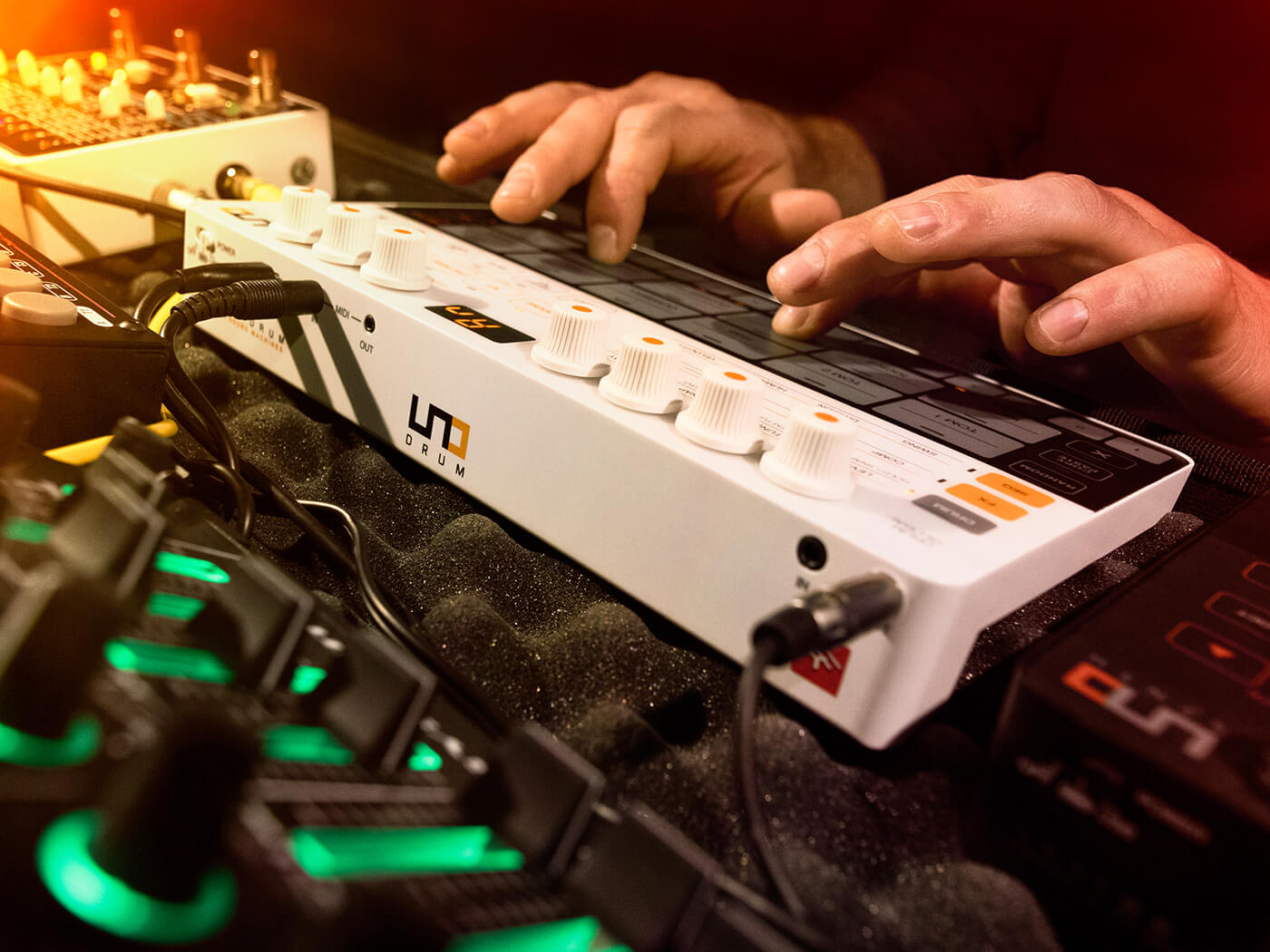
As well as the impressively boomy analogue kicks, the PCM sounds take you on a varied journey. From top left to right, the toms can be anything from the simple and electronic Roland-a-likes to more rounded and lengthier hits. The Rim sounds, too, go from clicks to shrill almost bird-like tweets. The Cowbell again covers that TR electronic sound, right through to less bell and more wooden sharp hits. The rides and cymbals are quite lovely, again electronic to more acoustic – although you do start to wish that there was an onboard reverb here to really extend those tails.
That’s something that would also benefit the snare sounds, although there are enough with longer sustains here should you wish to veer too far back to the 80s. Indeed, at least one of the PCM claps appears to have been recorded with reverb on, so you can at least get that effect within a Pattern. Again, you get varying lengths of clap here, from this longer one to an almost cricket-like hit.
Overall, most of the sounds included are therefore very electronic in nature, as this drum machine is very much offering sounds for dance, hip-hop and EDM production, so don’t buy UNO Drum expecting faithful recreations of acoustic kits.
The number of sounds might initially sound a little tight, but each one is also tweaked by that main Matrix, top left, which features different controls for pretty much every preset type, although this number varies depending on the sonic Element that you have selected. With most of the sounds, for example, you get access to the Level, Tune and Decay options which you select and then adjust with the dials above. However, some of the analogue sounds give you extra parameters to adjust, accessed by holding the Drum button for 1.5 seconds. Kick1, for example, adds some FM-parameter-like Tune and Sweep Time.
With the PCM-type sounds, you’re able to control Level (velocity), Tune and Decay. It should be stated that Velocity is a set amount (either 100 or 127 and set using the Alt button) when you play the pads, so each of these pads is not velocity sensitive when you perform with them. However, using the matrix, you can program the level of each velocity, so there’s flexibility here and as we’ll see with the sequencer later, you can introduce a more human feel.
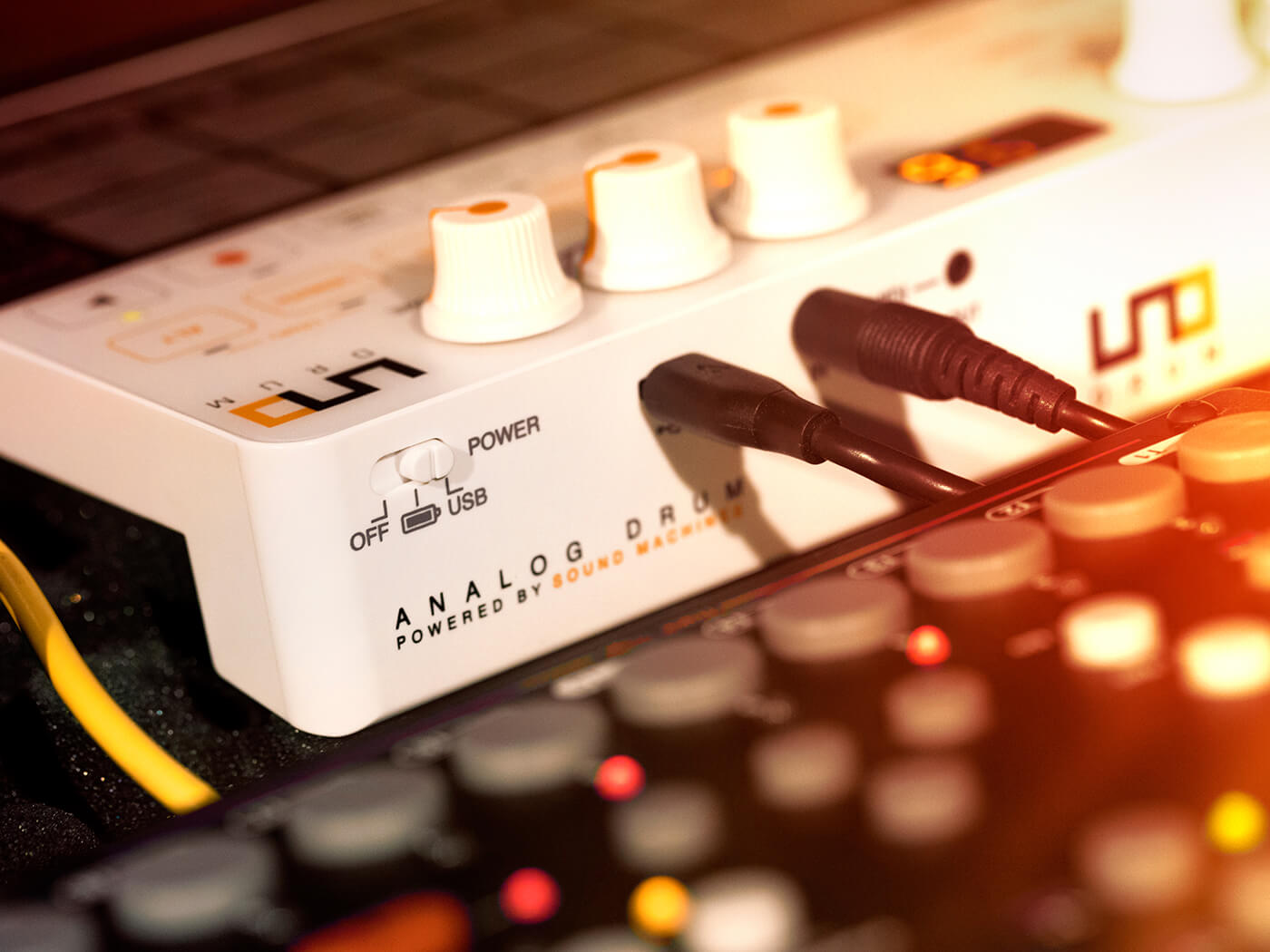
With all of these Matrix options in place, you can see that, even though there might be just 60 sounds to start with, using the various parameters does introduce a lot of variation. Even using UNO’s tuning feature alone, for example, you are massively expanding its sonic reach. Further to this is a range of four effects in the next line of the Matrix which offer a very obvious compressor – with more crunch than most – and a Drive effect that adds a large dose of dirt. There are two further performance effects which we’ll cover later.
Once you’re happy tweaking your 12 Element kit sounds here, you can then save them as a kit simply by pressing and holding the Kit button, choosing a location and pressing it again.
Patterns and performance
Next up, you should head on over to the right hand side and hit play. Now your chosen kit will come to life as one of 100 Patterns plays around the kit you have selected, with the central dial here controlling the tempo. This is a great place to get a proper feel for what UNO Drum is capable of, as the kits have been produced to demonstrate the full sonic range of the unit with tuning and other effects programmed in. There is an impressive variety, from the more robotic-like number 80 to many an 808/909-alike, to even the odd almost acoustic-like kit, although the emphasis is, as stated and perhaps expectedly, very much on the electronic side of music production.
Here, you can also try out some of the unit’s impressive performance effects; MIDI-type processes that enhance the playback of the patterns in various ways. The Random button is perhaps the least conventional in that it inserts a random number of hits per selected sound within a pattern. You hold the Random button down, select an Element and it goes to work, also randomising the velocity of the steps. Hit the Select All button and all the elements get randomised, so it can quickly get out of control and you might wish for an Undo button.
Stutter is better, introducing 10 different real-time repeat effects. The Stutter type determines the number of steps being repeated and the Amount determines the number of Elements affected by it.
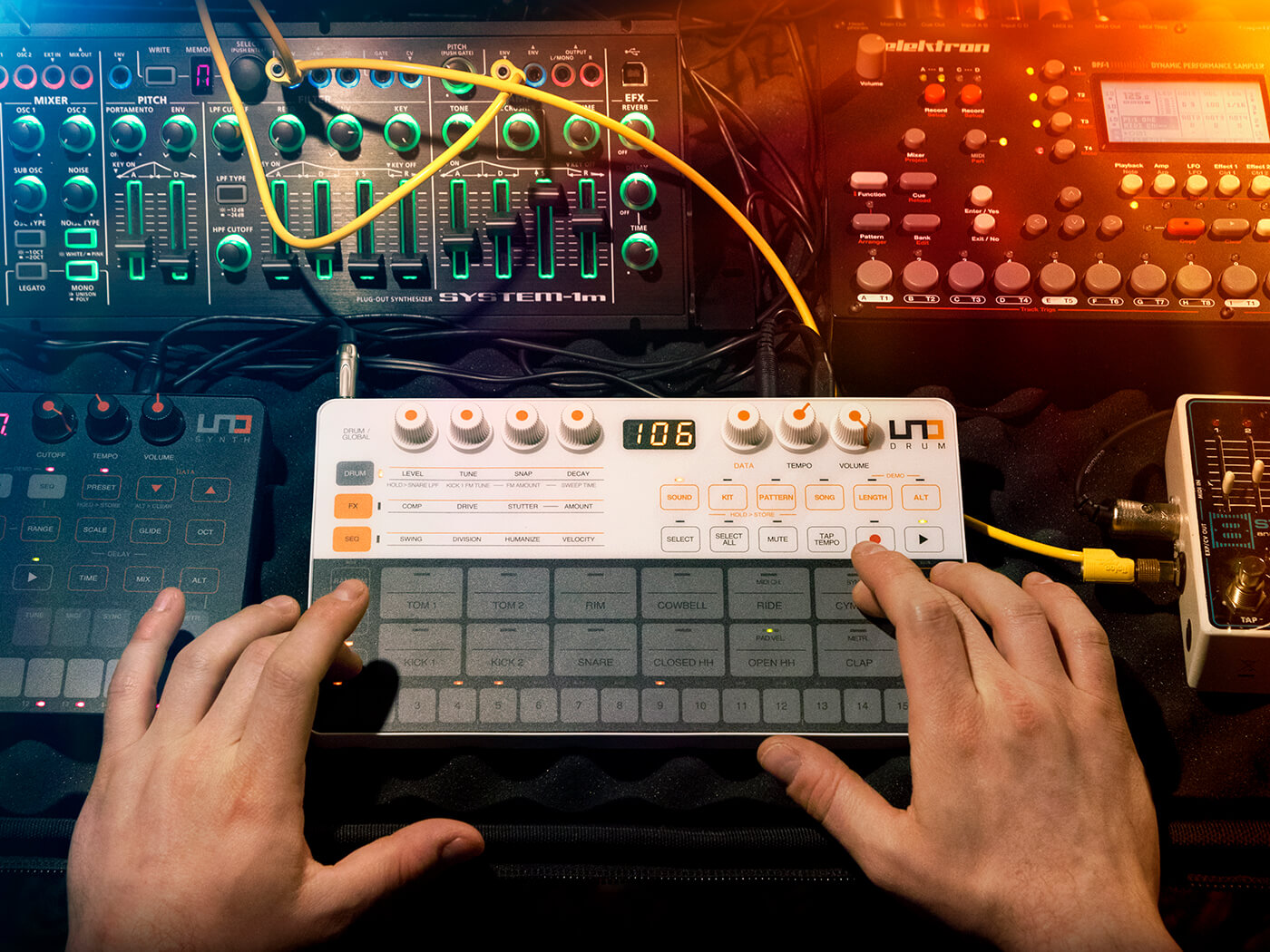
So Type 1, for example, repeats the first eight steps after the Stutter button is pressed. When Amount level 1 is selected, it only affects the kick drum; Amount level 12 affects all 12 Elements. The Stutter types change loop length (to triplets, double triplets etc) or introduce different pre-programmed fill patterns as you go up. There are also a couple of tuning options (up and down) that change the Element (again, the number of which is determined by the Amount setting) and finally, two Madness options that randomise velocity, decay and tuning parameters over three or four steps – and it really can get mad.
The final, and less complex, performance option is Roll. This repeats individual selected Element sounds over four different Roll types (roll 8th note, 8th-note triplets, 16th note and 32nd note). It’s easy to get some impressive-sounding real-time movement here, especially when tuning up and down as you do it. Overall, these performance options certainly add a good UNO Drum angle, again stretching its sonics beyond what you might expect from such a small device.
UNO sequencing
The sequencing part of UNO Drum is pretty straightforward. You work in Patterns, which can be up to 64 steps in length (with the default set at 16). You can either record in real time as the Pattern cycles around (after you press record), or use step recording, where you simply select an element and then highlight a step for it to play (press the step again to remove it). It’s very easy to get a Pattern together and then you can chain up to 64 of these together to produce an entire Song.
Each step within a Pattern can also have up to eight parameters automated, which helps add a lot of variation per Pattern – you can, for example, record entire rolls and tunings should you wish and these types of effects can sound fantastic in practice. However, I did have trouble with the Clear button’s ability to actually get rid of some of my bum notes and I ended up having to simply switch them off in the Step mode instead.
Finally within the sequencer, you can return to the Matrix to access further Swing, Division, Humanize and Velocity options that all contribute to helping your grooves sound less robotic, introducing both timing and velocity variations into the mix. Overall, the sequencer really is one of the most powerful parts of UNO Drum, yet surprisingly easy to get your head around.
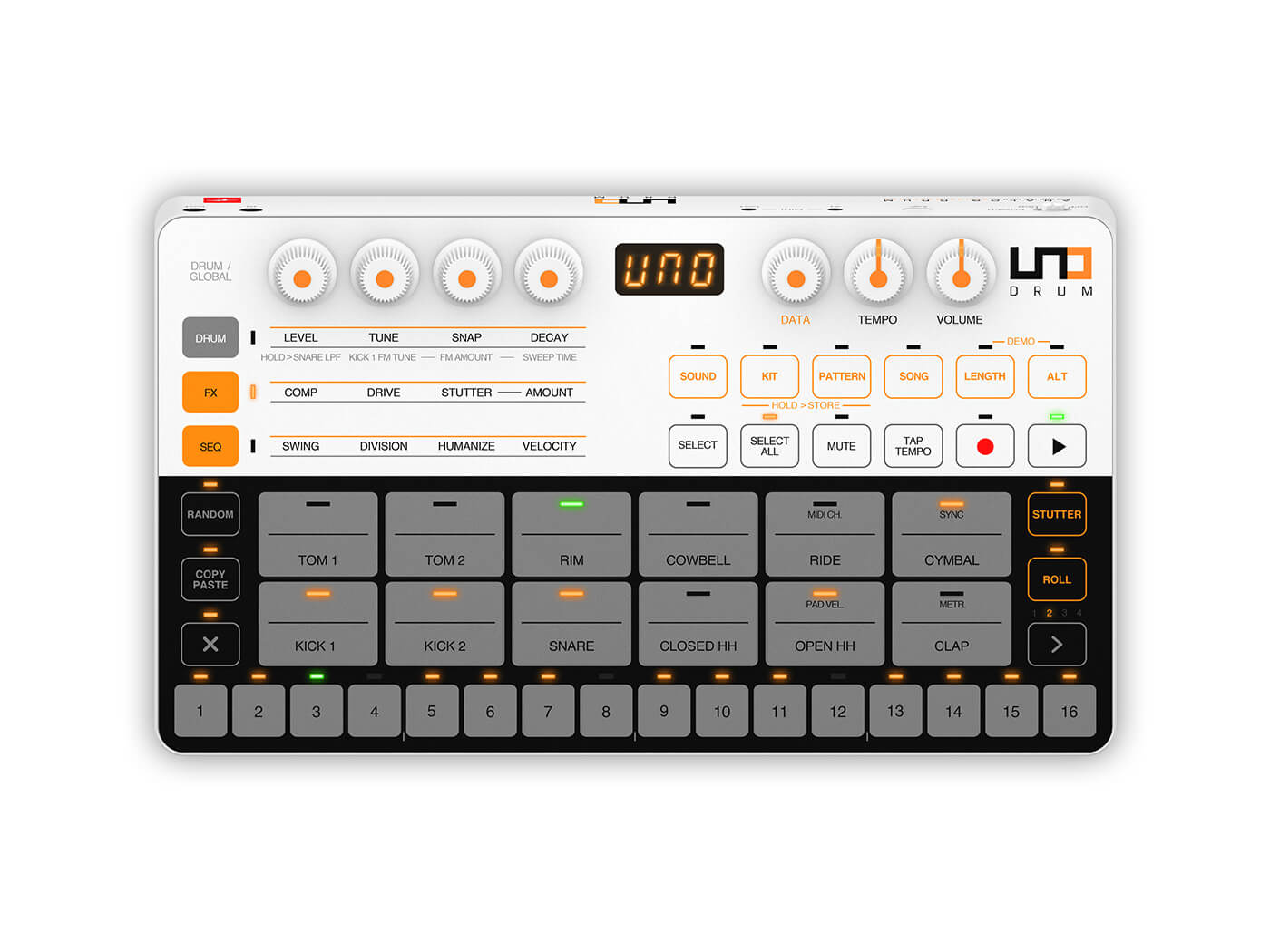
I’ll finally quickly cover off some of the other features of UNO Drum, starting with the Copy/Paste button. With this, you can quickly copy steps and patterns (both individual Elements within a pattern or the whole thing).
The Alt button, as previously referred to for changing the set velocity, also gives you access to MIDI, Sync (internal or external), tempo and metronome options, all via the Ride, Cymbal, Open Hat and Clap pads. Tap Tempo and Mute options obviously do what they say, and finally the arrow button simply allows you to step through up to four pages of your Pattern in steps of 16.
Conclusion
UNO Drum is a more sonically flexible piece of hardware than you might initially think. You can certainly manipulate each of its 60 available kit sounds to an impressive degree to produce a huge variety of beats – and the sequencing and programming options are both deep and easy to employ.
With UNO Synth, I was very much a fan of the non-moving-parts philosophy – I really didn’t mind the touch keyboard in that unit – but I’m not sure regular percussionists will be so forgiving with UNO Drum. There’s something about hitting proper pads with proper velocity sensitivity that makes using hardware that much better than using software and you simply don’t get that tactile response with these touch pads. Yes, they do keep the price down but UNO Drum is still a good 20 per cent more expensive than the synth version, which is a shame. That higher price point also places it – albeit at a street-price level – towards some impressively spec’d competition (see alternatives, below).
That said, there is an impressive amount of beat action to be had from this diminutive box and I can see it working well linked and sync’d up to the synth. The performance options are also very hands-on and usable and give UNO Drum some flexible live credentials.
But perhaps UNO Drum’s greatest strengths are its analogue sounds and what you can do with them; you can simply bend, stretch, meld and sweep all the onboard supplied analogue sounds to whatever degree you wish for (and most of the PCM ones) and could spend hours doing just this to come up with your own extreme kits. Perhaps we may even see additional sounds added with a software update.
Either way, as it stands, UNO Drum is another small and lightweight piece of IK hardware that delivers beyond its weight. Long may this trend for cheap, powerful and feature-packed hardware continue – it’s a great and affordable time for music production.
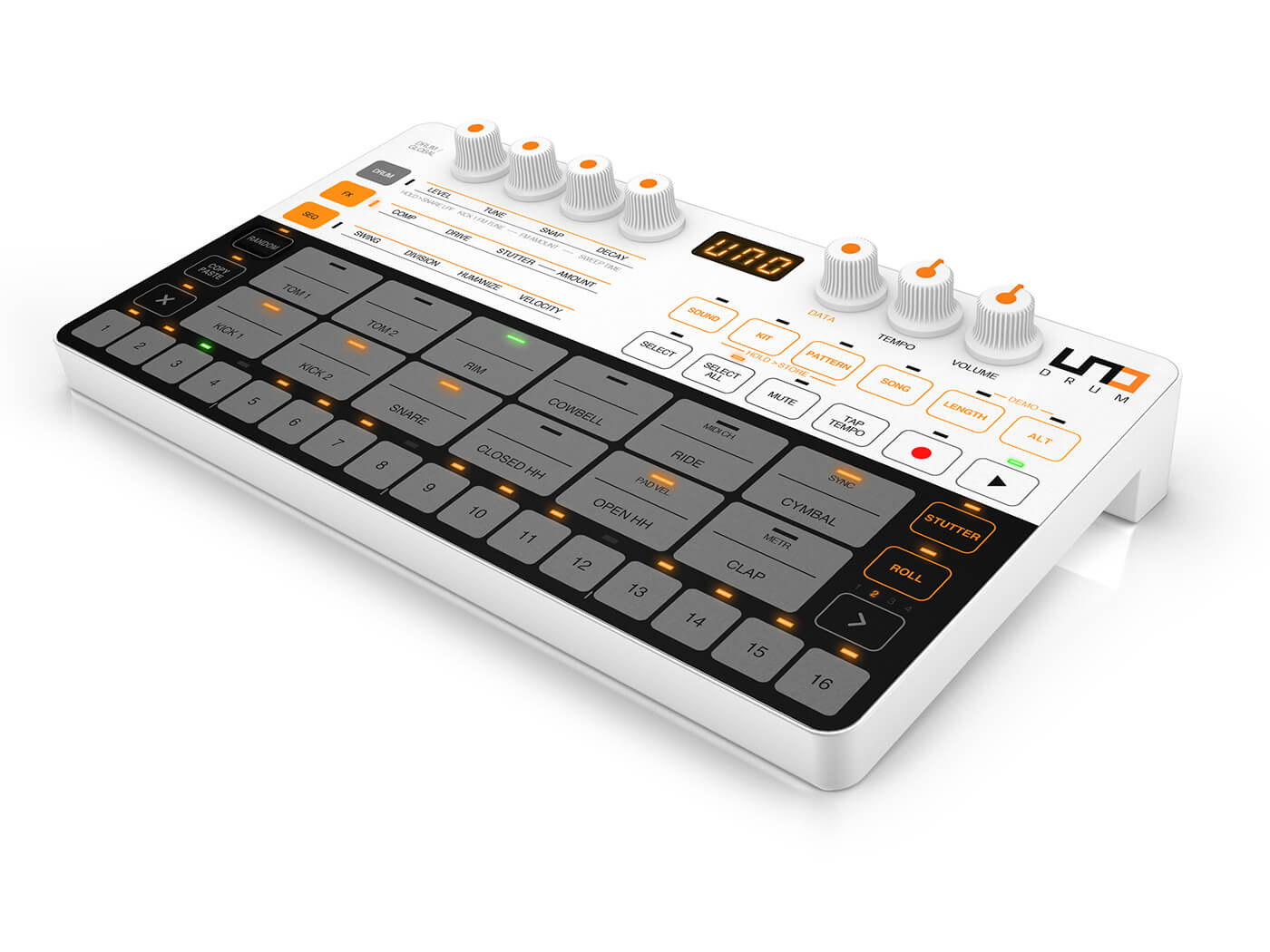
Three UNO Drum performance extras
Stutter Stutter allows you to choose from 10 different types of repeat and you can adjust the level of each.
Random Quite a bonkers effect that allows you to randomise how Elements are played within a pattern.
Roll Repeats whatever sound you have selected. The pattern and timing is changed with the Data dial
IK Multimedia UNO Drum overview
Matrix section This main grid allows access to four parameters at a time for each sound, including tuning, level (velocity) and decay.
Effects and sequencer parameters The grid also allows you to edit effect parameters for sounds and performances and also to access sequencer data.
Global controls You get dials for Tempo and Volume, plus a Data dial allows you to select Sounds (from 5), kits (from 100) and Patterns (from 100).
12 ’element’ pads Each sound in UNO Drum is called an Element, accessed from a choice of five per pad. Up to six can be analogue, up to to 12 PCM.
Sequencer It’s easy to record your drum parts in real time, as a pattern cycles around, or select a step and then an Element (sound) to play on that step.
Sequencer controls and effects The main transport controls are here and you also get two performance effects, including 10 Stutters and Rolls.
Do I really need this?
With any hardware, the first question you could ask is: can I do it cheaper in software? The answer in most cases is probably ‘yes’, but UNO Drum is part of the new breed of low-cost hardware machines that gives you the tactile feel of hardware for a low cost. So the question could be is: should you replace your software with hardware!? And in this case, you really can do it.
Key features
- Analogue/PCM drum machine
- 100 kits, 100 patterns, 11-voice polyphony
- 12 drum Elements (kick x2, snare, closed and open hat, clap, cymbal, ride, cowbell, rim, tom x2)
- Up to six analogue sounds; or 12 PCM sounds from 54
- Four dynamic Matrix controls plus one global, two fixed
- Five performance effects
- 64-step real- and step-time sequencer with up to 8 parameters/step and 100 drum patterns
- Connections: audio I/O (3.5mm), MIDI I/O, USB
- Size (w x d x h): 256 x 150 x 49mm
Alternatives
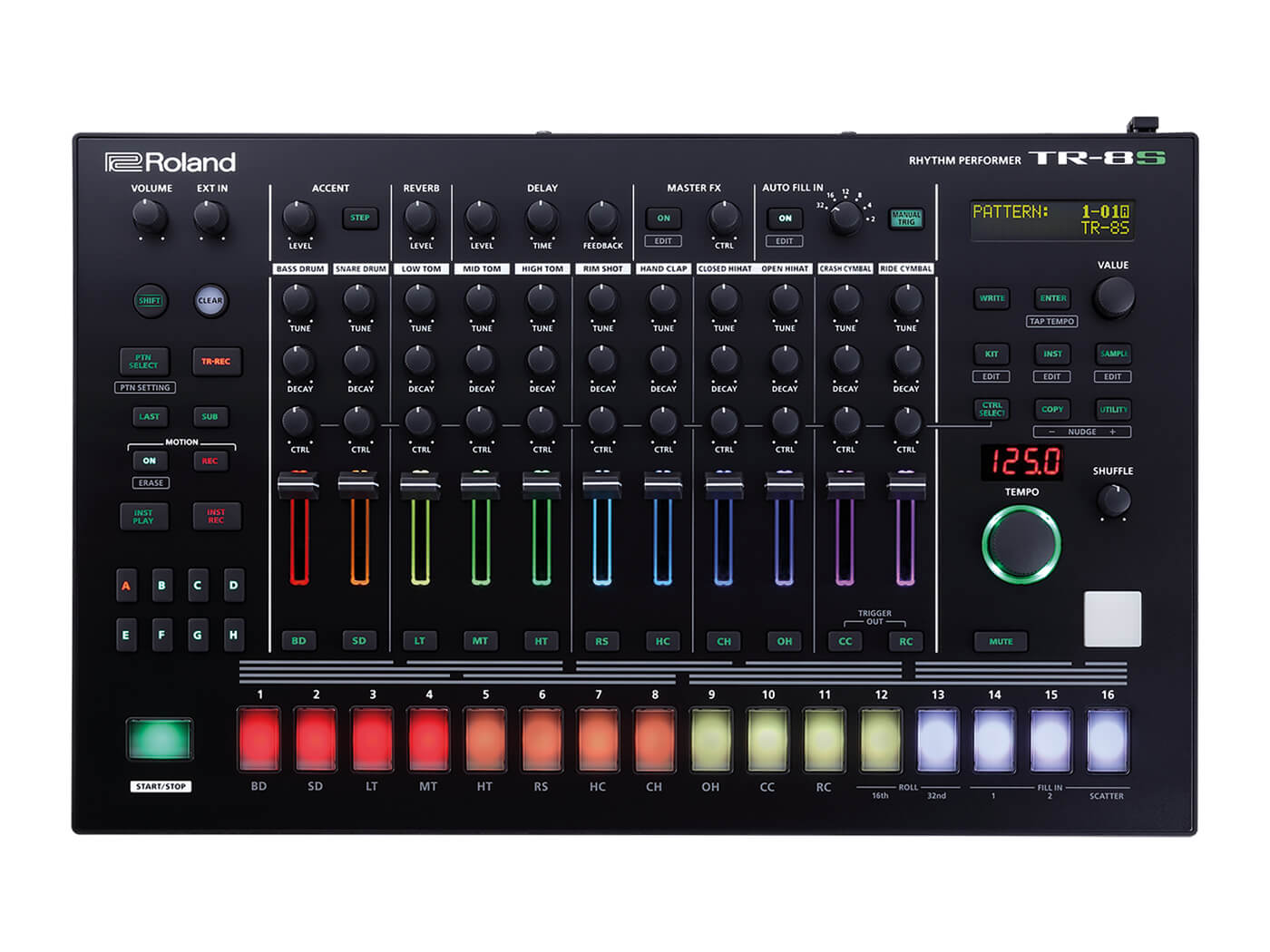
This is obviously a bigger and bolder machine, but does have a similar sonic outlook. TR-8S also offers an impressive amount of actual hands on control with faders and dials aplenty. However, it is nearly twice the price and not very portable.
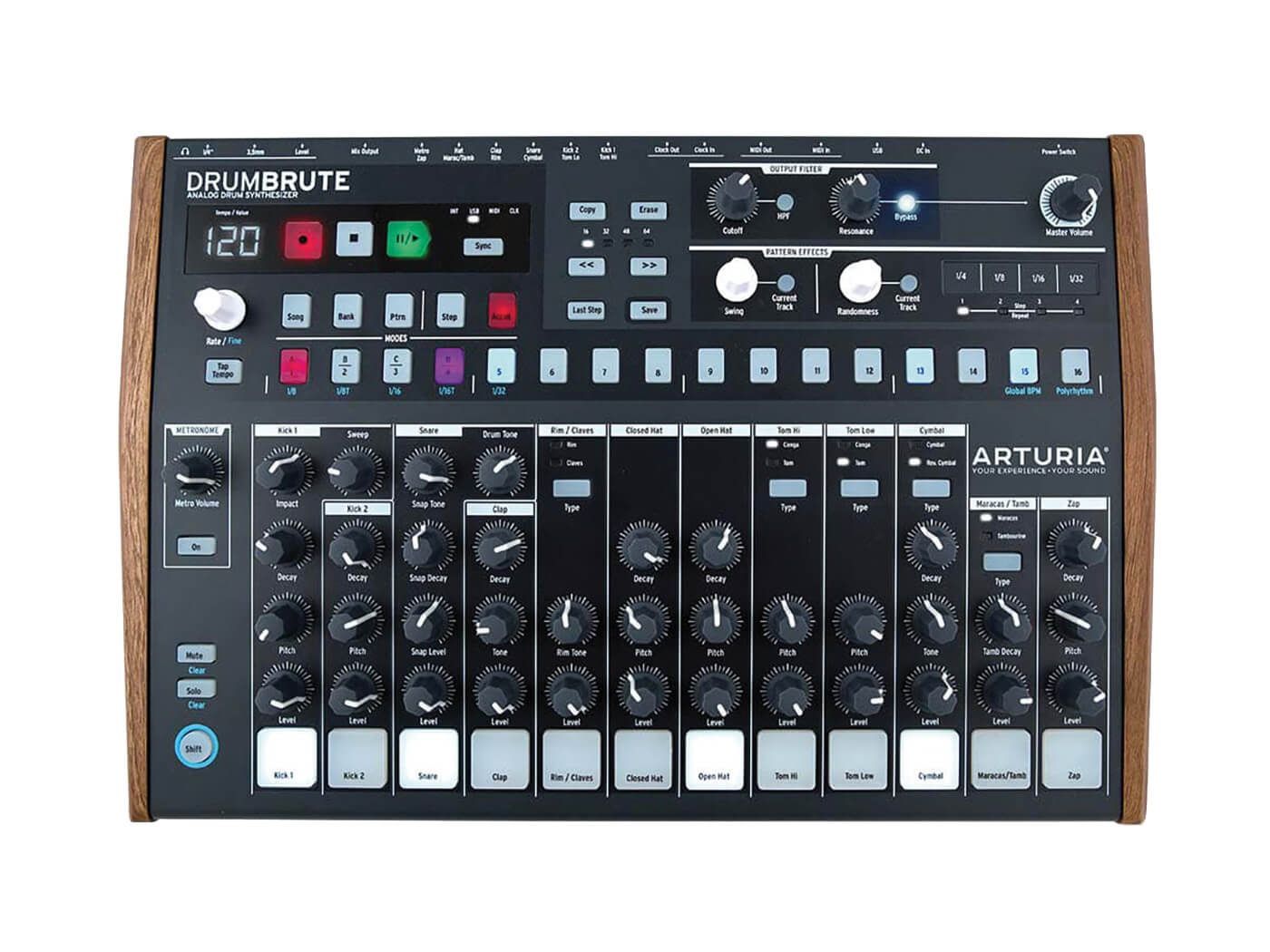
The fact that DrumBrute is streeting for such a low amount pitches it fair and square at UNO Drum. You get a hell of a lot of percussive action for that small outlay, including 17 fully analogue percussion instruments and an impressive 12 outputs.